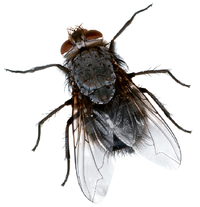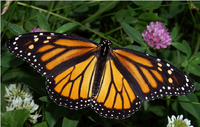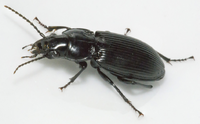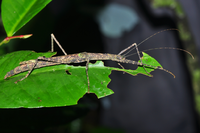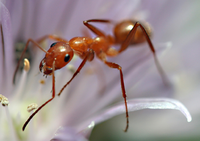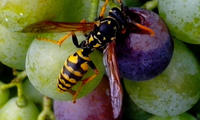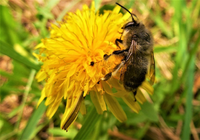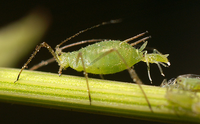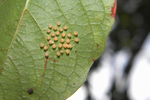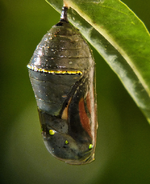Difference between revisions of "Insect"
(→About Insects) |
|||
| (9 intermediate revisions by the same user not shown) | |||
| Line 1: | Line 1: | ||
| + | ==Key Stage 1== | ||
| + | ===Meaning=== | ||
An [[animal]] without a [[backbone]] and with 6 jointed legs. | An [[animal]] without a [[backbone]] and with 6 jointed legs. | ||
| + | |||
| + | ===About Insects=== | ||
| + | : There are many different types of '''insect'''. These are just some of the types: | ||
| + | *Flies | ||
| + | *Butterflies | ||
| + | *Moths | ||
| + | *Beetles | ||
| + | *Stick Insects | ||
| + | *Ants | ||
| + | *Wasps | ||
| + | *Bees | ||
| + | *Aphids | ||
| + | |||
| + | {| class="wikitable" | ||
| + | |+ All of these creatures have 6 jointed legs as adults. | ||
| + | |- | ||
| + | |[[File:Fly.png|center|200px]] | ||
| + | |[[File:Butterfly.png|center|200px]] | ||
| + | |[[File:Moth.png|center|200px]] | ||
| + | |- | ||
| + | | style="height:20px; width:200px; text-align:center;" |There are many different types of fly. | ||
| + | | style="height:20px; width:200px; text-align:center;" |A butterfly is an insect. | ||
| + | | style="height:20px; width:200px; text-align:center;" |A moth is a [[nocturnal]] insect. | ||
| + | |- | ||
| + | |[[File:Beetle1.png|center|200px]] | ||
| + | |[[File:StickInsect.png|center|200px]] | ||
| + | |[[File:Ant.png|center|200px]] | ||
| + | |- | ||
| + | | style="height:20px; width:200px; text-align:center;" |There are over 10,000 different kinds of beetle. | ||
| + | | style="height:20px; width:200px; text-align:center;" |Stick insects have evolved to look like sticks to hide from [[Predator|predators]]. | ||
| + | | style="height:20px; width:200px; text-align:center;" |Ants live in big groups called a 'colony'. | ||
| + | |- | ||
| + | |[[File:Wasp.png|center|200px]] | ||
| + | |[[File:BeePollinate1.png|center|200px]] | ||
| + | |[[File:Aphid.png|center|200px]] | ||
| + | |- | ||
| + | | style="height:20px; width:200px; text-align:center;" |Wasps are '''insects''' that sting to defend their nest. | ||
| + | | style="height:20px; width:200px; text-align:center;" |Not all bees make honey or live in hives. Most types of bee live on their own. | ||
| + | | style="height:20px; width:200px; text-align:center;" |An aphid is a 'pest' that damages plants. | ||
| + | |} | ||
| + | |||
| + | ==Key Stage 2== | ||
| + | ===Meaning=== | ||
| + | An '''insect''' is an [[invertebrate]] with 6 jointed legs. | ||
| + | |||
| + | ===About Insects=== | ||
| + | : All adult '''insects''' have 6 legs. | ||
| + | |||
| + | {| class="wikitable" | ||
| + | |'''Eggs''' | ||
| + | |'''Larva''' | ||
| + | |'''Pupa''' | ||
| + | |'''Adult''' | ||
| + | |- | ||
| + | |[[File:ButterflyEggs.png|center|150px]] | ||
| + | |[[File:Caterpillar.png|center|150px]] | ||
| + | |[[File:ButterflyPupa.png|center|150px]] | ||
| + | |[[File:Butterfly.png|center|150px]] | ||
| + | |- | ||
| + | | style="height:20px; width:150px; text-align:center;" |'''Insects''' lay eggs. | ||
| + | | style="height:20px; width:150px; text-align:center;" |The eggs hatch and a larva comes out. This larva is called a caterpillar. | ||
| + | | style="height:20px; width:150px; text-align:center;" |The larva makes a pupa where the larva can change into the adult. | ||
| + | | style="height:20px; width:150px; text-align:center;" |The adult '''insect''' hatches from the pupa. In this case the adult is a butterfly. | ||
| + | |} | ||
| + | |||
| + | ==Key Stage 3== | ||
| + | ===Meaning=== | ||
| + | An '''insect''' is an [[invertebrate]] with 6 jointed legs. | ||
| + | |||
| + | ==Key Stage 4== | ||
| + | ===Meaning=== | ||
| + | An '''insect''' is an [[invertebrate]] with 6 jointed legs. | ||
| + | |||
| + | ==Beyond the Curriculum== | ||
| + | {{#ev:youtube|https://www.youtube.com/watch?v=BvLolPN8NvU}} | ||
Latest revision as of 19:50, 19 April 2019
Contents
Key Stage 1
Meaning
An animal without a backbone and with 6 jointed legs.
About Insects
- There are many different types of insect. These are just some of the types:
- Flies
- Butterflies
- Moths
- Beetles
- Stick Insects
- Ants
- Wasps
- Bees
- Aphids
| There are many different types of fly. | A butterfly is an insect. | A moth is a nocturnal insect. |
| There are over 10,000 different kinds of beetle. | Stick insects have evolved to look like sticks to hide from predators. | Ants live in big groups called a 'colony'. |
| Wasps are insects that sting to defend their nest. | Not all bees make honey or live in hives. Most types of bee live on their own. | An aphid is a 'pest' that damages plants. |
Key Stage 2
Meaning
An insect is an invertebrate with 6 jointed legs.
About Insects
- All adult insects have 6 legs.
| Eggs | Larva | Pupa | Adult |
| Insects lay eggs. | The eggs hatch and a larva comes out. This larva is called a caterpillar. | The larva makes a pupa where the larva can change into the adult. | The adult insect hatches from the pupa. In this case the adult is a butterfly. |
Key Stage 3
Meaning
An insect is an invertebrate with 6 jointed legs.
Key Stage 4
Meaning
An insect is an invertebrate with 6 jointed legs.
